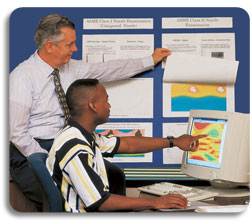
Capturing Mission-Critical Knowledge of Retiring Experts
 |
Utilities today face the challenge that, as their older, experienced employees retire, they take with them rare, mission-critical knowledge that only they know. This knowledge may include special ways of analyzing and solving problems, ways that are not taught in schools or found in books, and that may not be readily understandable—either to new engineers or even experienced utility people performing functions that depend on the expert's abilities.
Capturing and transferring such knowledge is inherently difficult, and commonly used approaches are seldom effective. For example, training or mentoring takes years, and even so, such person-to-person transfer does not make knowledge broadly accessible to others or preserve it for future generations.
EPRI's Human Performance Technology Program has developed tools and a streamlined process for capturing expert knowledge that are unique in the industry. The process involves three stages: identifying the valuable knowledge to be captured, planning which tools would be most effective at capturing the identified expertise, and implementing the plan, resulting in knowledge modules that can be easily transferred to others.
EPRI recently worked with several utilities to apply this process to capture the specialized knowledge of retiring experts. Public Service Electric & Gas (PSE&G) faced the retirement of two experts—one in System Protection, the other in Pipe-Type Cables. To elicit their knowledge, the EPRI team met with each expert in a series of structured interview sessions, and also interviewed the prospective users of the captured knowledge to determine their needs.
Out of these interviews, the team developed a series of knowledge modules. For example, for the system protection case, the knowledge modules included text—an overview of asset management functions and an "analysis of events" document that describes the expert's thought processes—and an Excel spreadsheet matrix that includes relay protection schemes, types of equipment protected, and voltage levels, as well as historical information for specific protection schemes.
PSE&G is in the process of placing these knowledge modules on the company's intranet to provide field personnel with fast access to expert information to help solve problems.
Consolidated Edison Company of New York (Con Edison) experienced the retirement of its Chief District Operator. This widely regarded expert, and his successor, are responsible for personnel safety and the day-to-day operation of the electric distribution system in Manhattan, the most complex distribution system in the world. The EPRI team worked with the outgoing and incoming Chief District Operators to capture insights and strategies used to sustain operational excellence and a robust, integrated safety program.
A series of interviews was again used, and the resulting product was a living document, used as a desktop guide. The incoming Chief uses the guide with his direct reports, senior management, and others as a basis document for the evolving, shared strategy. The guide also serves as a source for development of potential successors in the future. The EPRI method is flexible, and often is applied to less complex domains than above. For example, often "tribal" or informal knowledge is undocumented, yet commonly used by experienced individual contributors. Rapid workforce turnover puts this knowledge at risk, yet the EPRI toolkit has simple guidance that captures such undocumented knowledge, validates it, and makes it available to many others.
This was the case when the Con Edison customer service department lost a key billing process expert to a promotion/transfer. The expert had been the go-to person for an entire department on complex billing processes. In a short interview, a knowledge elicitation team, consisting of a customer service manager and an EPRI knowledge elicitor, identified the key component by which the expert stood above his peers. It was his internal "big picture," built over time, by which he could integrate the scattered, informal sources of information that were valuable. With this internal perspective, he could respond rapidly and correctly when others struggled. Once captured, this big picture view was easily communicated in a desktop guide along with the previously scattered sources.
In each of these cases, the utility benefits by preserving continuity in work performance, even as individuals succeed one another. The EPRI knowledge capture processes help ensure that the retiring worker's experience, lessons learned, and insights acquired over months and years of service are transmitted in a useable form to the direct replacements as well as future workers in those positions. As a result, in the long run, the utility can be less dependent on external consultants and realize reduced costs and continued system reliability.